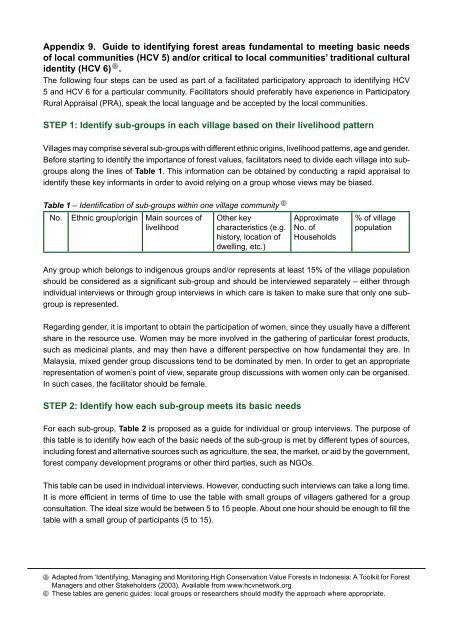(HCVF) Toolkit for Malaysia - HCV Resource Network
(HCVF) Toolkit for Malaysia - HCV Resource Network
(HCVF) Toolkit for Malaysia - HCV Resource Network
You also want an ePaper? Increase the reach of your titles
YUMPU automatically turns print PDFs into web optimized ePapers that Google loves.
Appendix 9. Guide to identifying <strong>for</strong>est areas fundamental to meeting basic needs<br />
of local communities (<strong>HCV</strong> 5) and/or critical to local communities’ traditional cultural<br />
17<br />
identity (<strong>HCV</strong> 6) .<br />
The following four steps can be used as part of a facilitated participatory approach to identifying <strong>HCV</strong><br />
5 and <strong>HCV</strong> 6 <strong>for</strong> a particular community. Facilitators should preferably have experience in Participatory<br />
Rural Appraisal (PRA), speak the local language and be accepted by the local communities.<br />
STEP 1: Identify sub-groups in each village based on their livelihood pattern<br />
Villages may comprise several sub-groups with different ethnic origins, livelihood patterns, age and gender.<br />
Be<strong>for</strong>e starting to identify the importance of <strong>for</strong>est values, facilitators need to divide each village into subgroups<br />
along the lines of Table 1. This in<strong>for</strong>mation can be obtained by conducting a rapid appraisal to<br />
identify these key in<strong>for</strong>mants in order to avoid relying on a group whose views may be biased.<br />
Table 1 – Identification of sub-groups within one village community<br />
No. Ethnic group/origin Main sources of<br />
livelihood<br />
18<br />
Other key<br />
characteristics (e.g.<br />
history, location of<br />
dwelling, etc.)<br />
Approximate<br />
No. of<br />
Households<br />
% of village<br />
population<br />
Any group which belongs to indigenous groups and/or represents at least 15% of the village population<br />
should be considered as a significant sub-group and should be interviewed separately – either through<br />
individual interviews or through group interviews in which care is taken to make sure that only one subgroup<br />
is represented.<br />
Regarding gender, it is important to obtain the participation of women, since they usually have a different<br />
share in the resource use. Women may be more involved in the gathering of particular <strong>for</strong>est products,<br />
such as medicinal plants, and may then have a different perspective on how fundamental they are. In<br />
<strong>Malaysia</strong>, mixed gender group discussions tend to be dominated by men. In order to get an appropriate<br />
representation of women’s point of view, separate group discussions with women only can be organised.<br />
In such cases, the facilitator should be female.<br />
STEP 2: Identify how each sub-group meets its basic needs<br />
For each sub-group, Table 2 is proposed as a guide <strong>for</strong> individual or group interviews. The purpose of<br />
this table is to identify how each of the basic needs of the sub-group is met by different types of sources,<br />
including <strong>for</strong>est and alternative sources such as agriculture, the sea, the market, or aid by the government,<br />
<strong>for</strong>est company development programs or other third parties, such as NGOs.<br />
This table can be used in individual interviews. However, conducting such interviews can take a long time.<br />
It is more efficient in terms of time to use the table with small groups of villagers gathered <strong>for</strong> a group<br />
consultation. The ideal size would be between 5 to 15 people. About one hour should be enough to fill the<br />
table with a small group of participants (5 to 15).<br />
17<br />
18<br />
Adapted from ‘Identifying, Managing and Monitoring High Conservation Value Forests in Indonesia: A <strong>Toolkit</strong> <strong>for</strong> Forest<br />
Managers and other Stakeholders (2003). Available from www.hcvnetwork.org<br />
These tables are generic guides: local groups or researchers should modify the approach where appropriate.

















